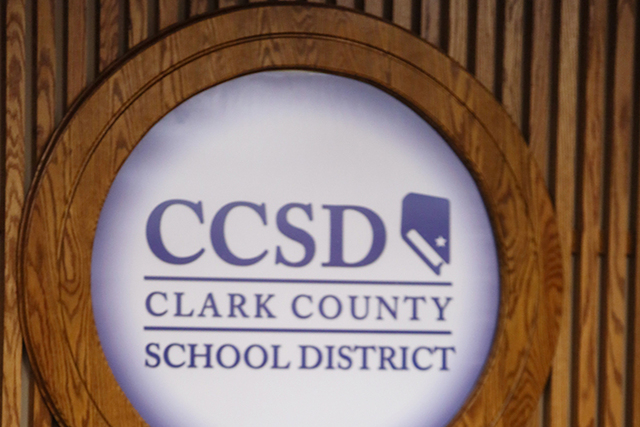CCSD: More performance ratings fall than rise
When Faiss Middle School teachers walked into the library for lunch Friday, their eyes fell on stars.
Five stars, to be exact, covering the walls.
“From the bottom of my heart, as a former teacher and principal, just know we’re thrilled to celebrate what you’ve done,” said Clark County Superintendent Pat Skorkowsky, who surprised staff with the good news. The southwest valley school, near Maule Avenue and Fort Apache Road, has jumped from a rating of four stars to five stars.
Families, principals, teachers and government officials statewide were counting stars Friday as the Nevada Department of Education announced the ratings of all 633 public schools, updated to reflect their 2013-14 performances. Each school landed one to five stars based on points earned in categories, such as the percentage of students at grade level in math and reading/writing skills, the percentage of students progressing at or above an expected rate, and average daily attendance. High school scores also factor in the graduation rate and the percentage of students who are credit deficient or taking advanced courses.
Although Clark County School District leaders gathered Friday to honor Faiss for earning another star, such a thing was far from the norm for area schools. More local schools lost stars than gained them.
While 57 county schools improved and added a star or two, another 73 schools were downgraded. The number of one-star schools doubled for the second year in a row, jumping from three schools in 2012 to six schools in 2013, and now 13 schools in 2014. The state began its current rating system, called the Nevada School Performance Framework, in 2012.
“Most schools held their own,” emphasized Skorkowsky on Friday, referencing the 207 schools that maintained their star ratings from 2012-13 to 2013-14.
So, where’d most of the schools rate for the nation’s fifth-largest district?
The largest number by far – 143 schools or 42 percent of Clark County’s campuses – were awarded three stars, what many would consider a C grade for meeting some standards. Some groups have criticized the Nevada Department of Education’s scoring scale for being too lenient, awarding three stars to schools falling in the range of 50 to 68 points out of 100. To earn five stars, a school must earn a minimum 77 points out of 100.
About 28 percent of area schools earned one or two stars, making these 95 schools low performers. About the same amount, 30 percent or 110 schools, earned four or five stars.
The district’s top-scoring schools were the usual suspects with strong past performances: College of Southern Nevada’s three high school campuses; Rogich, Webb, Canarelli, Indian Springs and Hyde Park middle schools; and Twitchell, Bonner and Vanderburg elementary schools.
Overall, middle and high schools improved while elementary schools struggled, said district Chief Student Achievement Officer Mike Barton.
Elementary schools account for the largest number of district campuses — 217 out of Clark County’s 357 schools. Many experienced downgrades. The district’s list of low-performing elementary schools grew by a third from 52 schools in 2013 to 69 schools in 2014.
Hancock Elementary School, near Oakey Boulevard and Lindell Road, fell from five to three stars, due to a sharp drop in state test results. What was 75 percent of third-graders reading at grade level in 2013 dropped to 58 percent in 2014.
“We know there’s work to do at elementary schools,” said Barton, who didn’t blame student crowding at elementary schools, which pushed these campuses an average of 18 percent past their buildings’ maximum capacities. “We’re not looking for excuses.”
While elementary schools’ enrollments grew to 1,000 students or more at many campuses, class sizes decreased. The district reported an average kindergarten class size of 19 students, down from 26. Those improvements extended through the elementary grades to 18 students in first grade, 19 students in second and third grades, and 24 students in fourth and fifth grades, down from 29 students in 2013.
This was possible through several means, most notably the reliance on portable classrooms, currently numbering 1,872 at elementary schools, said district Chief Financial Officer Jim McIntosh.
Even with the smaller class sizes at every level, many Clark County students continue to advance to the next grade level without the expected skills. Every spring, the state tests students in math and reading from third through eighth grade.
In 2013-14, state tests found only 60 percent of third-graders reading at grade level and 64 percent scoring proficient in math. By eighth grade, those proficiency rates dropped to 52 percent in reading and 37 percent in math.
“There’s always work to do,” said Barton, pointing to Faiss as an example to be followed.
Faiss staff attributed the success to collaboration. Teachers in the same grade level meet regularly and share their successes in “show-n-tell” sessions.
Those practices are similar to what’s being done at Triggs Elementary School, according to Principal Sheila Cooper. The school, near Decatur Boulevard and Deer Springs Way, was one of seven schools in Clark County to jump from three to five stars in 2014.
The others were Heckethorn, Hinman, Hoggard and O’Roarke elementary schools, Indian Springs Middle School and Sandy Valley High School.
“There are some schools achieving tremendous results, but the vast majority have remained unchanged since last year,” said Nevada Superintendent of Public Instruction Dale Erquiaga in releasing the ratings on Friday, adding that “too many continue to lag far behind.”
The trend that emerged in Clark County is reflected statewide, with 158 of Nevada’s 633 schools — about 25 percent — earning just one or two stars.
To see individual school star ratings, go to the Nevada School Performance Framework website at nspf.doe.nv.gov. To view a school’s Report Card, including detailed information on test scores, student demographics, funding, staffing and discipline, visit nevadareportcard.com.
Review-Journal Database Editor Brian Haynes contributed to this report.
Contact Trevon Milliard at tmilliard@reviewjournal.com or 702-383-0279. Find him on Twitter: @TrevonMilliard.







































